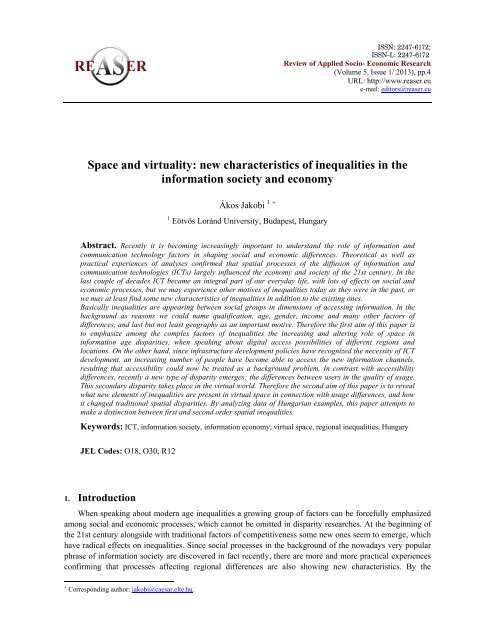new characteristics of inequalities in the information society and ...
new characteristics of inequalities in the information society and ...
new characteristics of inequalities in the information society and ...
You also want an ePaper? Increase the reach of your titles
YUMPU automatically turns print PDFs into web optimized ePapers that Google loves.
ISSN: 2247-6172;<br />
ISSN-L: 2247-6172<br />
Review <strong>of</strong> Applied Socio- Economic Research<br />
(Volume 5, Issue 1/ 2013), pp.4<br />
URL: http://www.reaser.eu<br />
e-mail: editors@reaser.eu<br />
Space <strong>and</strong> virtuality: <strong>new</strong> <strong>characteristics</strong> <strong>of</strong> <strong><strong>in</strong>equalities</strong> <strong>in</strong> <strong>the</strong><br />
<strong>in</strong>formation <strong>society</strong> <strong>and</strong> economy<br />
Ákos Jakobi 1 <br />
1 Eötvös Loránd University, Budapest, Hungary<br />
Abstract. Recently it is becom<strong>in</strong>g <strong>in</strong>creas<strong>in</strong>gly important to underst<strong>and</strong> <strong>the</strong> role <strong>of</strong> <strong>in</strong>formation <strong>and</strong><br />
communication technology factors <strong>in</strong> shap<strong>in</strong>g social <strong>and</strong> economic differences. Theoretical as well as<br />
practical experiences <strong>of</strong> analyses confirmed that spatial processes <strong>of</strong> <strong>the</strong> diffusion <strong>of</strong> <strong>in</strong>formation <strong>and</strong><br />
communication technologies (ICTs) largely <strong>in</strong>fluenced <strong>the</strong> economy <strong>and</strong> <strong>society</strong> <strong>of</strong> <strong>the</strong> 21st century. In <strong>the</strong><br />
last couple <strong>of</strong> decades ICT became an <strong>in</strong>tegral part <strong>of</strong> our everyday life, with lots <strong>of</strong> effects on social <strong>and</strong><br />
economic processes, but we may experience o<strong>the</strong>r motives <strong>of</strong> <strong><strong>in</strong>equalities</strong> today as <strong>the</strong>y were <strong>in</strong> <strong>the</strong> past, or<br />
we may at least f<strong>in</strong>d some <strong>new</strong> <strong>characteristics</strong> <strong>of</strong> <strong><strong>in</strong>equalities</strong> <strong>in</strong> addition to <strong>the</strong> exist<strong>in</strong>g ones.<br />
Basically <strong><strong>in</strong>equalities</strong> are appear<strong>in</strong>g between social groups <strong>in</strong> dimensions <strong>of</strong> access<strong>in</strong>g <strong>in</strong>formation. In <strong>the</strong><br />
background as reasons we could name qualification, age, gender, <strong>in</strong>come <strong>and</strong> many o<strong>the</strong>r factors <strong>of</strong><br />
differences, <strong>and</strong> last but not least geography as an important motive. Therefore <strong>the</strong> first aim <strong>of</strong> this paper is<br />
to emphasize among <strong>the</strong> complex factors <strong>of</strong> <strong><strong>in</strong>equalities</strong> <strong>the</strong> <strong>in</strong>creas<strong>in</strong>g <strong>and</strong> alter<strong>in</strong>g role <strong>of</strong> space <strong>in</strong><br />
<strong>in</strong>formation age disparities, when speak<strong>in</strong>g about digital access possibilities <strong>of</strong> different regions <strong>and</strong><br />
locations. On <strong>the</strong> o<strong>the</strong>r h<strong>and</strong>, s<strong>in</strong>ce <strong>in</strong>frastructure development policies have recognized <strong>the</strong> necessity <strong>of</strong> ICT<br />
development, an <strong>in</strong>creas<strong>in</strong>g number <strong>of</strong> people have become able to access <strong>the</strong> <strong>new</strong> <strong>in</strong>formation channels,<br />
result<strong>in</strong>g that accessibility could now be treated as a background problem. In contrast with accessibility<br />
differences, recently a <strong>new</strong> type <strong>of</strong> disparity emerges: <strong>the</strong> differences between users <strong>in</strong> <strong>the</strong> quality <strong>of</strong> usage.<br />
This secondary disparity takes place <strong>in</strong> <strong>the</strong> virtual world. Therefore <strong>the</strong> second aim <strong>of</strong> this paper is to reveal<br />
what <strong>new</strong> elements <strong>of</strong> <strong><strong>in</strong>equalities</strong> are present <strong>in</strong> virtual space <strong>in</strong> connection with usage differences, <strong>and</strong> how<br />
it changed traditional spatial disparities. By analyz<strong>in</strong>g data <strong>of</strong> Hungarian examples, this paper attempts to<br />
make a dist<strong>in</strong>ction between first <strong>and</strong> second order spatial <strong><strong>in</strong>equalities</strong>.<br />
Keywords: ICT, <strong>in</strong>formation <strong>society</strong>, <strong>in</strong>formation economy, virtual space, regional <strong><strong>in</strong>equalities</strong>, Hungary<br />
JEL Codes: O18, O30, R12<br />
1. Introduction<br />
When speak<strong>in</strong>g about modern age <strong><strong>in</strong>equalities</strong> a grow<strong>in</strong>g group <strong>of</strong> factors can be forcefully emphasized<br />
among social <strong>and</strong> economic processes, which cannot be omitted <strong>in</strong> disparity researches. At <strong>the</strong> beg<strong>in</strong>n<strong>in</strong>g <strong>of</strong><br />
<strong>the</strong> 21st century alongside with traditional factors <strong>of</strong> competitiveness some <strong>new</strong> ones seem to emerge, which<br />
have radical effects on <strong><strong>in</strong>equalities</strong>. S<strong>in</strong>ce social processes <strong>in</strong> <strong>the</strong> background <strong>of</strong> <strong>the</strong> nowadays very popular<br />
phrase <strong>of</strong> <strong>in</strong>formation <strong>society</strong> are discovered <strong>in</strong> fact recently, <strong>the</strong>re are more <strong>and</strong> more practical experiences<br />
confirm<strong>in</strong>g that processes affect<strong>in</strong>g regional differences are also show<strong>in</strong>g <strong>new</strong> <strong>characteristics</strong>. By <strong>the</strong><br />
Correspond<strong>in</strong>g author: jakobi@caesar.elte.hu.








